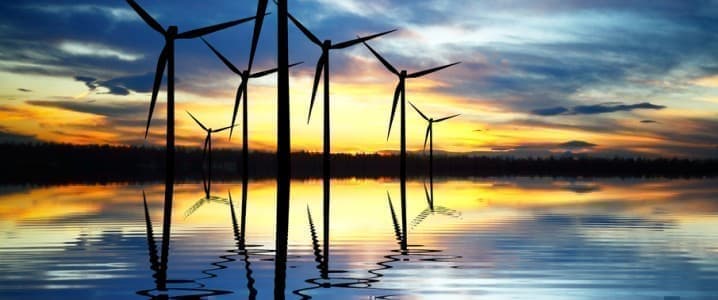Danish researchers at Aarhus University have developed a chemical process that can disassemble the epoxy composite of wind turbine blades – and simultaneously extract intact glass fibers as well as one of the epoxy resin’s original building blocks in a high-quality. The recovered materials could potentially be used in the production of new blades.
The research paper has been published in the leading scientific journal Nature, and Aarhus University, together with the Danish Technological Institute, has filed a patent application for the process.
The new chemical process is not limited to wind turbine blades but works on many different so-called fiber-reinforced epoxy composites, including some materials that are reinforced with especially costly carbon fibers.
Thus, the process can contribute to establishing a potential circular economy in the wind turbine, aerospace, automotive and space industries, where these reinforced composites, due to their lightweight and long durability, are used for load-bearing structures.

After six days of catalysis in the laboratory, a piece of a wind turbine blade was dissolved into intact glass fibers and bisphenol A, which can be used in the production of new blades – in addition to a fraction of various oligomers, which cannot be recycled. The metal piece was cast into the wing as part of the wind turbine’s lightning protection. Image Credit: Alexander Ahrens, Aarhus University. Click the press release link for the largest view.
Being designed to last, the durability of the blades poses an environmental challenge. Wind turbine blades mostly end up at waste landfills when they are decommissioned, because they are extremely difficult to break down.
If no solution is found, we will have accumulated 43 million metric tons of wind turbine blade waste globally by 2050.
The newly discovered process is a proof-of-concept of a recycling strategy that can be applied to the vast majority of both existing wind turbine blades and those presently in production, as well as other epoxy-based materials.
Specifically, the researchers have shown that by using a ruthenium-based catalyst and the solvents isopropanol and toluene, they can separate the epoxy matrix and release one of the epoxy polymer’s original building blocks, bisphenol A (BPA), and fully intact glass fibers in a single process.
However, the method is not immediately scalable yet, as the catalytic system is not efficient enough for industrial implementation – and ruthenium is a rare and expensive metal. Therefore, the scientists from Aarhus University are continuing their work on improving this methodology.
Troels Skrydstrup, a professor at the Department of Chemistry and the Interdisciplinary Nanoscience Center (iNANO) at Aarhus University and one of the lead authors of the study commented, “Nevertheless, we see it as a significant breakthrough for the development of durable technologies that can create a circular economy for epoxy-based materials. This is the first publication of a chemical process that can selectively disassemble an epoxy composite and isolate one of the most important building blocks of the epoxy polymer as well as the glass or carbon fibers without damaging the latter in the process.”
The research is supported by the CETEC project (Circular Economy for Thermosets Epoxy Composites), which is a partnership between Vestas, Olin Corporation, the Danish Technological Institute and Aarhus University.
***
This is interesting news. While not economical by a description not explained, there is a known way now to answer the bedeviling problem of what to do with the blades that aren’t useable.
There’s going to be a catalyst hunt to replace the ruthenium and there might need to be quite an engineering effort. Toluene isn’t something we should allow to simply evaporate into the atmosphere. They’re going to need robotic handlers in a gas-tight facility and very likely a way to reliquify the toluene and other chemicals.
But it can and should be done. A facility is just going to need big treatment tanks and the process will be far more expensive than anyone thought. There are a lot of blades now and its likely a huge number are going to be built.
By Brian Westenhaus via Newenergyandfuel.com
More Top Reads From Oilprice.com:
- Why OPEC Is Increasingly Frustrated With The IEA
- A Secret War Is Brewing In The South China Sea
- Huge Volumes Of Crude Oil Are Headed To China



















Unfortunately it doesn’t solve the two biggest problems of wind energy: intermittence and storage.
The notions of a global energy transition and net-zero emissions are illusions. Even a partial transition won’t succeed without major contributions from natural gas and to some extent nuclear power and coal. The reason is the intermittent nature of renewables.
Today’s technology won’t allow us to save solar electricity generated in summer for use in winter because of lack of large enough battery storage.
That is why wind and solar energy is neither capable of even running any kind of economy nor are they able to solve today’s energy problems.
Dr Mamdouh G Salameh
International Oil Economist
Global Energy Expert
Hot plasma fusion likely never works for durable reactors since no wall can resist long against plasma heat rays better cold fusion shooting Hg mercury into D2O heavy water for D-D later D-T fusion and shoot faster Hg neutrons spallation to Hg-197 for decay gold.
Addable new turbine cycle with CO2 or Hg instead H2O and instead a wasting cooled condensor a sucking centrifugal compressor blower backflow cooling (indirect) that way all of the system thermal isolatable efficiency near 100%
Future CANDU HTR with liquid ammonia as ND3 (N-15) instead D2O between tubes out of RBN cubic boron nitride isotopes B-11 & N-15 also for fuel cladding unriched UO2 baked inside BN withouz QuadTriso for 30 year fuel runtime because ot better moderation and less neutrons lost leading to as much breeding like fission controlable over ND3 pressure bubbles and i stead H2O as coolant in tubes lithium-7 from 180 to 1340°C without pressure and moderating like in molten salt HTR (LiF&BeF) for security one storey sand upon and MgO under etc.